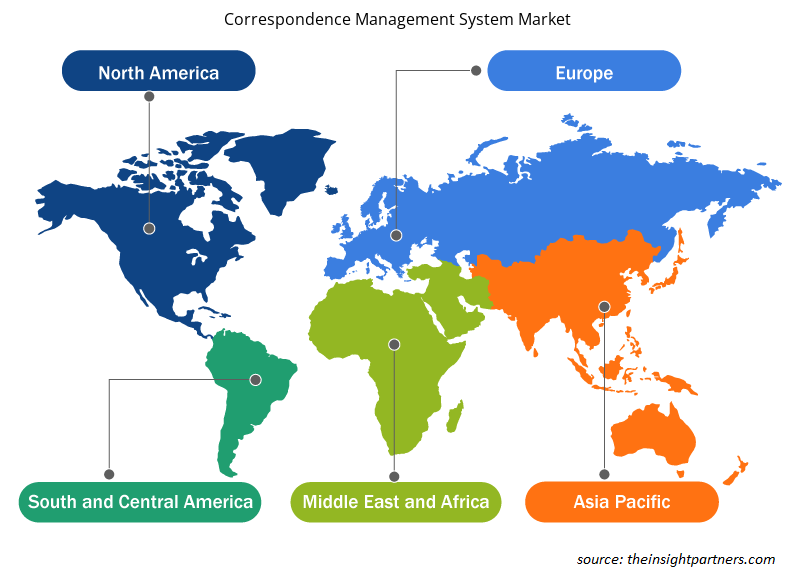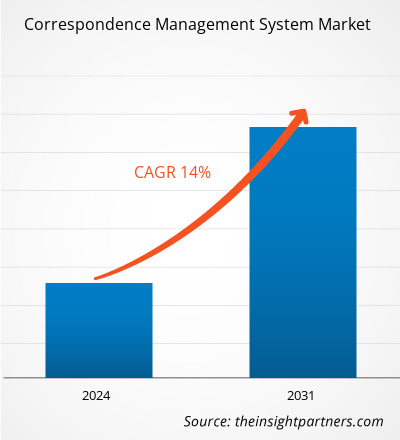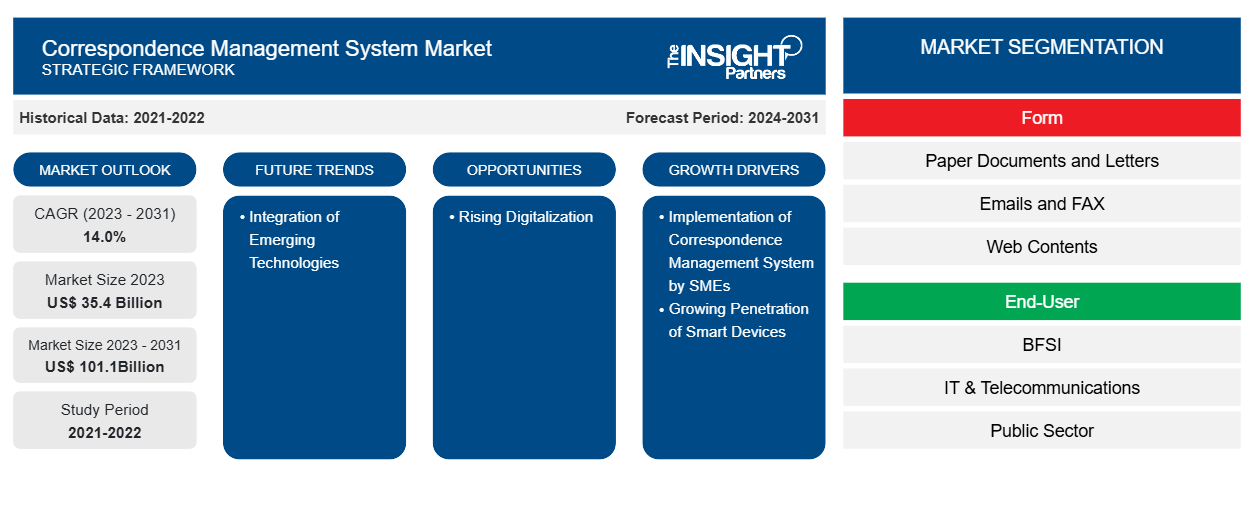Der Markt für Korrespondenzmanagementsysteme soll von 35,4 Milliarden US-Dollar im Jahr 2023 auf 101,1 Milliarden US-Dollar im Jahr 2031 anwachsen. Der Markt wird voraussichtlich zwischen 2023 und 2031 eine durchschnittliche jährliche Wachstumsrate von 14,0 % verzeichnen. Die zunehmende Verbreitung intelligenter Geräte und die Integration neuer Technologien dürften weiterhin die wichtigsten Trends auf dem Markt für Korrespondenzmanagementsysteme bleiben.
Marktanalyse für Korrespondenzmanagementsysteme
Verschiedene Faktoren treiben das Wachstum von Korrespondenzmanagementsystemen voran. Dazu gehören die zunehmende Nutzung intelligenter Geräte, die Fähigkeit der Software, Daten per E-Mail zu übermitteln, und die zunehmende Betonung des Umweltschutzes durch reduzierten Papierverbrauch. Darüber hinaus spielt auch die Automatisierung von Poststellen zur Verbesserung der internen und externen Kommunikation eine wichtige Rolle bei diesem Wachstum.
Marktübersicht für Korrespondenzmanagementsysteme
Ein Softwaresystem zur Verwaltung der Korrespondenz wird verwendet, um die gesamte interne und externe Unternehmenskommunikation in einer Organisation zu überwachen und Mitarbeitern je nach ihrer Rolle Zugriff zu gewähren. Dieses System erleichtert die Speicherung, den Abruf und die Übermittlung von Mitteilungen zur Überprüfung und Genehmigung. Es bietet die Möglichkeit, eine große Menge an E-Mails , ob elektronisch oder physisch, sowie Faxe und andere herkömmliche Methoden effizient zu verarbeiten. Diese Systeme ermöglichen es Unternehmen, Nachrichten mit vorab genehmigtem und angepasstem Inhalt in einem optimierten Prozess effizient zu sammeln. Letztendlich ermöglicht ein Korrespondenzmanagementsystem Unternehmen, die Qualität der Kundenkommunikation zu verbessern und die mit dem Kommunikationsprozess verbundenen Kosten und Auswirkungen zu minimieren.
Passen Sie diesen Bericht Ihren Anforderungen an
Sie erhalten kostenlos individuelle Anpassungen an jedem Bericht, einschließlich Teilen dieses Berichts oder einer Analyse auf Länderebene, eines Excel-Datenpakets sowie tolle Angebote und Rabatte für Start-ups und Universitäten.
-
Holen Sie sich die wichtigsten Markttrends aus diesem Bericht.Dieses KOSTENLOSE Beispiel umfasst eine Datenanalyse von Markttrends bis hin zu Schätzungen und Prognosen.
Markttreiber und Chancen für Korrespondenzmanagementsysteme
Einführung eines Korrespondenzmanagementsystems durch KMU zur Förderung des Marktes
Unternehmen konzentrieren sich zunehmend auf kleine und mittlere Unternehmen, um ihren Umsatz und ihre Marktpräsenz zu steigern. Der zunehmende Trend zur Digitalisierung innerhalb von Unternehmen, der auf eine Steigerung der Betriebseffizienz und Kostensenkung abzielt, bietet Marktteilnehmern in Industrie- und Entwicklungsländern in absehbarer Zukunft erhebliche Wachstumsaussichten. Auf dem Markt für Korrespondenzmanagementsysteme präsentieren Unternehmen derzeit eine Reihe kostengünstiger Cloud-basierter Lösungen, die voraussichtlich erhebliche Möglichkeiten für Systemanbieter schaffen und sich positiv auf den Markt auswirken werden.
Zunehmende Digitalisierung
Die Nutzung von Content-Management-Lösungen wie Korrespondenzmanagementsystemen hat aufgrund der Digitalisierung zugenommen . Der Bedarf an effektiver Kommunikation und effizientem Dokumentenmanagement im digitalen Zeitalter treibt diesen Trend voran. Unternehmen nutzen digitale Technologien, um Dokumente zu bearbeiten und Kommunikationsprozesse effizient zu optimieren. Der anhaltende Trend zur Digitalisierung dürfte zu einem Marktwachstum für Korrespondenzmanagementsysteme führen. Die Digitalisierung hat die Akzeptanz von Content-Management-Lösungen wie Korrespondenzmanagementsystemen bei Unternehmen beschleunigt. Die Integration digitaler Tools zur Verbesserung des Informationszugriffs in allen Organisationen hat die Wahrscheinlichkeit erfolgreicher digitaler Transformationen deutlich erhöht, was die Auswirkungen der Digitalisierung auf die Implementierung von Content-Management-Lösungen unterstreicht.
Segmentierungsanalyse des Marktberichts zum Korrespondenzmanagementsystem
Wichtige Segmente, die zur Ableitung der Marktanalyse für Korrespondenzmanagementsysteme beigetragen haben, sind Form, Endbenutzer, Organisationsgröße und Anwendung.
- Basierend auf der Form ist der Markt in Papierdokumente und Briefe, E-Mails und Faxe, Webinhalte und elektronische Dokumente unterteilt. Das Segment Papierdokumente und Briefe hatte im Jahr 2023 einen bedeutenden Marktanteil.
- Nach Endnutzer ist der Markt segmentiert in BFSI , IT & Telekommunikation, öffentlicher Sektor, Einzelhandel & E-Commerce, Gesundheitswesen und andere. Das BFSI- Segment hielt im Jahr 2023 einen beträchtlichen Marktanteil.
- In Bezug auf die Unternehmensgröße ist der Markt in kleine und mittlere Unternehmen sowie in große Unternehmen unterteilt. Das Segment der großen Unternehmen hielt im Jahr 2023 einen erheblichen Marktanteil.
- Basierend auf der Anwendung ist der Markt in Diplomatentaschen, Poststellenautomatisierung, technische Dokumentenkontrolle und andere segmentiert. Das Segment Diplomatentaschen hielt im Jahr 2023 einen bedeutenden Marktanteil.
Marktanteilsanalyse für Korrespondenzmanagementsysteme nach Geografie
Der geografische Umfang des Marktberichts zum Korrespondenzmanagementsystem ist hauptsächlich in fünf Regionen unterteilt: Nordamerika, Asien-Pazifik, Europa, Naher Osten und Afrika sowie Südamerika/Süd- und Mittelamerika.
Der Markt für Korrespondenzmanagementsysteme in Nordamerika ist von erheblicher Bedeutung und wird von mehreren Faktoren vorangetrieben, wie etwa der zunehmenden Integration der Automatisierung, dem steigenden Bedarf an optimierter Kunden- und interner Kommunikation und der Notwendigkeit einer verbesserten internen und externen Kommunikation zur Stärkung der Kundenbindung in verschiedenen Branchen, darunter Einzelhandel und E-Commerce, BFSI und Regierung.
Regionale Einblicke in den Markt für Korrespondenzmanagementsysteme
Die regionalen Trends und Faktoren, die den Markt für Korrespondenzmanagementsysteme im Prognosezeitraum beeinflussen, wurden von den Analysten von Insight Partners ausführlich erläutert. In diesem Abschnitt werden auch die Marktsegmente und die Geografie von Korrespondenzmanagementsystemen in Nordamerika, Europa, im asiatisch-pazifischen Raum, im Nahen Osten und Afrika sowie in Süd- und Mittelamerika erörtert.

- Erhalten Sie regionale Daten zum Markt für Korrespondenzmanagementsysteme
Umfang des Marktberichts zum Korrespondenzmanagementsystem
| Berichtsattribut | Details |
|---|---|
| Marktgröße im Jahr 2023 | 35,4 Milliarden US-Dollar |
| Marktgröße bis 2031 | 101,1 Milliarden US-Dollar |
| Globale CAGR (2023 - 2031) | 14,0 % |
| Historische Daten | 2021-2022 |
| Prognosezeitraum | 2024–2031 |
| Abgedeckte Segmente |
Nach Formular
|
| Abgedeckte Regionen und Länder |
Nordamerika
|
| Marktführer und wichtige Unternehmensprofile |
|
Marktteilnehmerdichte: Der Einfluss auf die Geschäftsdynamik
Der Markt für Korrespondenzmanagementsysteme wächst rasant, angetrieben durch die steigende Nachfrage der Endnutzer aufgrund von Faktoren wie sich entwickelnden Verbraucherpräferenzen, technologischen Fortschritten und einem größeren Bewusstsein für die Vorteile des Produkts. Mit steigender Nachfrage erweitern Unternehmen ihr Angebot, entwickeln Innovationen, um die Bedürfnisse der Verbraucher zu erfüllen, und nutzen neue Trends, was das Marktwachstum weiter ankurbelt.
Die Marktteilnehmerdichte bezieht sich auf die Verteilung von Firmen oder Unternehmen, die in einem bestimmten Markt oder einer bestimmten Branche tätig sind. Sie gibt an, wie viele Wettbewerber (Marktteilnehmer) in einem bestimmten Marktraum im Verhältnis zu seiner Größe oder seinem gesamten Marktwert präsent sind.
Die wichtigsten auf dem Markt für Korrespondenzmanagementsysteme tätigen Unternehmen sind:
- Ademero, Inc.
- Adobe, Inc.
- Blue Project Software
- Cantec Irland
- DocPoint Solutions, Inc.
- Fabricated Software, Inc.
Haftungsausschluss : Die oben aufgeführten Unternehmen sind nicht in einer bestimmten Reihenfolge aufgeführt.

- Überblick über die wichtigsten Akteure auf dem Markt für Korrespondenzmanagementsysteme
Nachrichten und aktuelle Entwicklungen zum Markt für Korrespondenzmanagementsysteme
Der Markt für Korrespondenzmanagementsysteme wird durch die Erhebung qualitativer und quantitativer Daten nach Primär- und Sekundärforschung bewertet, die wichtige Unternehmenspublikationen, Verbandsdaten und Datenbanken umfasst. Im Folgenden finden Sie eine Liste der Entwicklungen auf dem Markt:
- Accelex, eine SaaS-Plattform, die sich auf die Erfassung, Berichterstattung und Analyse von alternativen Anlagedaten spezialisiert hat, hat heute die Einführung der ersten automatisierten Dokumenterfassungsfunktionen für den privaten Markt angekündigt, die eine beispiellose Geschwindigkeit, Genauigkeit und Effizienz bei der Erfassung und Analyse von Daten ermöglichen. Investoren und Vermögensverwalter können Accelex jetzt für die dynamische Konnektivität mit Dokumentquellen nutzen.
(Quelle: Accelex Technology Limited, Unternehmenswebsite, 2023)
Marktbericht zu Korrespondenzmanagementsystemen – Umfang und Ergebnisse
Der Bericht „Marktgröße und Prognose für Korrespondenzmanagementsysteme (2021–2031)“ bietet eine detaillierte Analyse des Marktes, die die folgenden Bereiche abdeckt:
- Marktgröße und Prognose auf globaler, regionaler und Länderebene für alle wichtigen Marktsegmente, die im Rahmen des Projekts abgedeckt sind
- Marktdynamik wie Treiber, Beschränkungen und wichtige Chancen
- Wichtige Zukunftstrends
- Detaillierte PEST/Porters Five Forces- und SWOT-Analyse
- Globale und regionale Marktanalyse mit wichtigen Markttrends, wichtigen Akteuren, Vorschriften und aktuellen Marktentwicklungen
- Branchenlandschaft und Wettbewerbsanalyse, einschließlich Marktkonzentration, Heatmap-Analyse, prominenten Akteuren und aktuellen Entwicklungen
- Detaillierte Firmenprofile
- Historische Analyse (2 Jahre), Basisjahr, Prognose (7 Jahre) mit CAGR
- PEST- und SWOT-Analyse
- Marktgröße Wert/Volumen – Global, Regional, Land
- Branchen- und Wettbewerbslandschaft
- Excel-Datensatz
Aktuelle Berichte
Verwandte Berichte
Erfahrungsberichte
Grund zum Kauf
- Fundierte Entscheidungsfindung
- Marktdynamik verstehen
- Wettbewerbsanalyse
- Kundeneinblicke
- Marktprognosen
- Risikominimierung
- Strategische Planung
- Investitionsbegründung
- Identifizierung neuer Märkte
- Verbesserung von Marketingstrategien
- Steigerung der Betriebseffizienz
- Anpassung an regulatorische Trends























 Kostenlose Probe anfordern für - Markt für Korrespondenzmanagementsysteme
Kostenlose Probe anfordern für - Markt für Korrespondenzmanagementsysteme